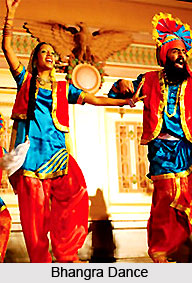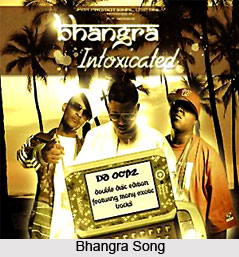 Bhangra is a form of music and dance that has its origins in the Punjab region of Pakistan and India. Bhangra dance began as a folk culture conducted by farmers to celebrate the coming of spring, a time known to be the Vaisakhi time. Today, bhangra survives in different forms and styles all over the world, including pop music, film soundtracks, and even competitions in colleges.
Bhangra is a form of music and dance that has its origins in the Punjab region of Pakistan and India. Bhangra dance began as a folk culture conducted by farmers to celebrate the coming of spring, a time known to be the Vaisakhi time. Today, bhangra survives in different forms and styles all over the world, including pop music, film soundtracks, and even competitions in colleges.The origin of Bhangra owes to the Vaisakhi festival celebrations of Punjabis and found its way to the stage performances after the division of the Punjab in 1947. The Punjabi dance performed at this time in delight with the beat of Dhol was given the formal name as Bhangra. The tradition spread slowly to other parts of the state and developed into a unique folk dance form in India. Bhangra has become a tradition and is now performed at every major celebration and in clubs etc.
Traditional Bhangra is a fusion of upbeat music, singing and the beat of the dhol drum, a single stringed instrument called the iktar (ektara), the tumbi and the chimta. The Bhangra songs that accompany the dance celebrations are small couplets written in the Punjabi language called bolis. These bolis relate to current issues faced by the singers and what they truly want to say about their culture. In Punjabi folk music, the dhol's smaller cousin, the dholki is frequently used to provide the main beat. However, in recent days the dhol is used more frequently, with and without the dholki. Extra percussion, including tabla, is not much used in bhangra as a solo instrument but is sometimes used along with the dhol and dholki. The dholki drum patterns in Bhangra songs put up with an intimate similarity to the rhythms in Reggae music. This rhythm is a common thread which allows for easy union between Bhangra and Reggae as demonstrated by such artists as the UK's Apache Indian.
During the last thirty years, Bhangra music has enjoyed the peak in popularity worldwide, both in traditional form and as a fusion with genres of music such as hip-hop, house, and reggae. In the late 1960s and 1970s, several Punjabi singers from the United Kingdom prepared the stage for Bhangra so that it can become a mass phenomenon. The singers/bands/artists related to Bhangra music include Jatinder Dhol Group, Kuldip Manak, the band heera, the band Alaap, A.S. Kang and others.

Major migrations of Punjabis to the Britain took the Bhangra music in the foreign land during the 1980s. Bhangra dancing was originally perceived as a male dance along with a "man's song", with strong, passionate movements. However, later the women have increasingly started dancing bhangra and portrayed it as a way of defining cultural identity. In the 1980's Bhangra artists were selling over 30,000 cassettes a week.
For more, visit the link below: